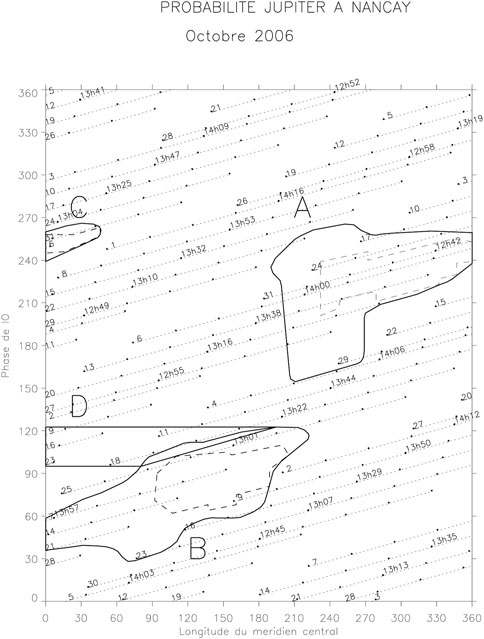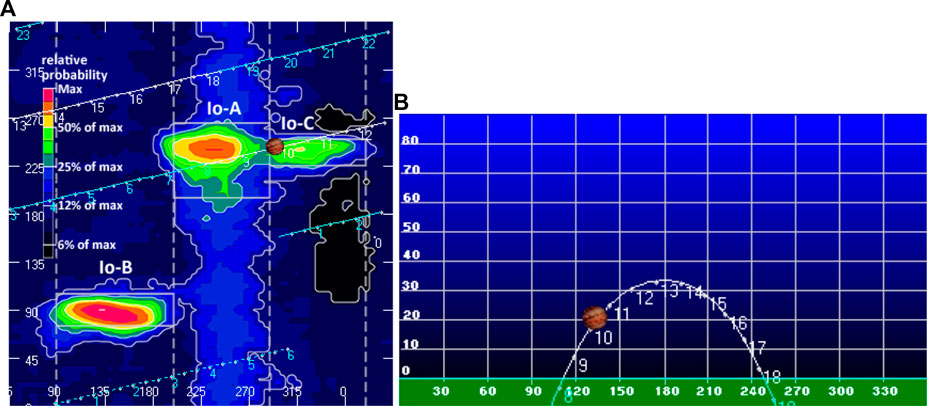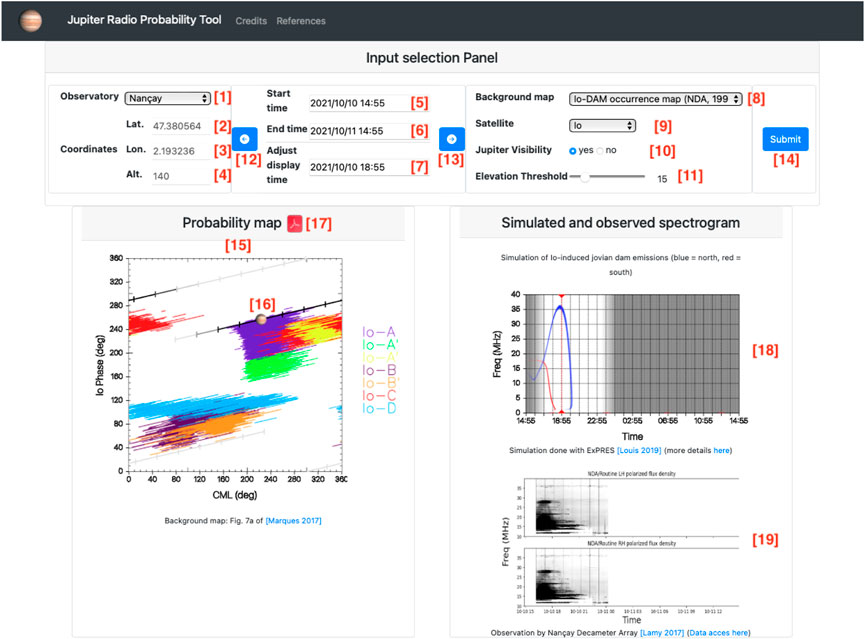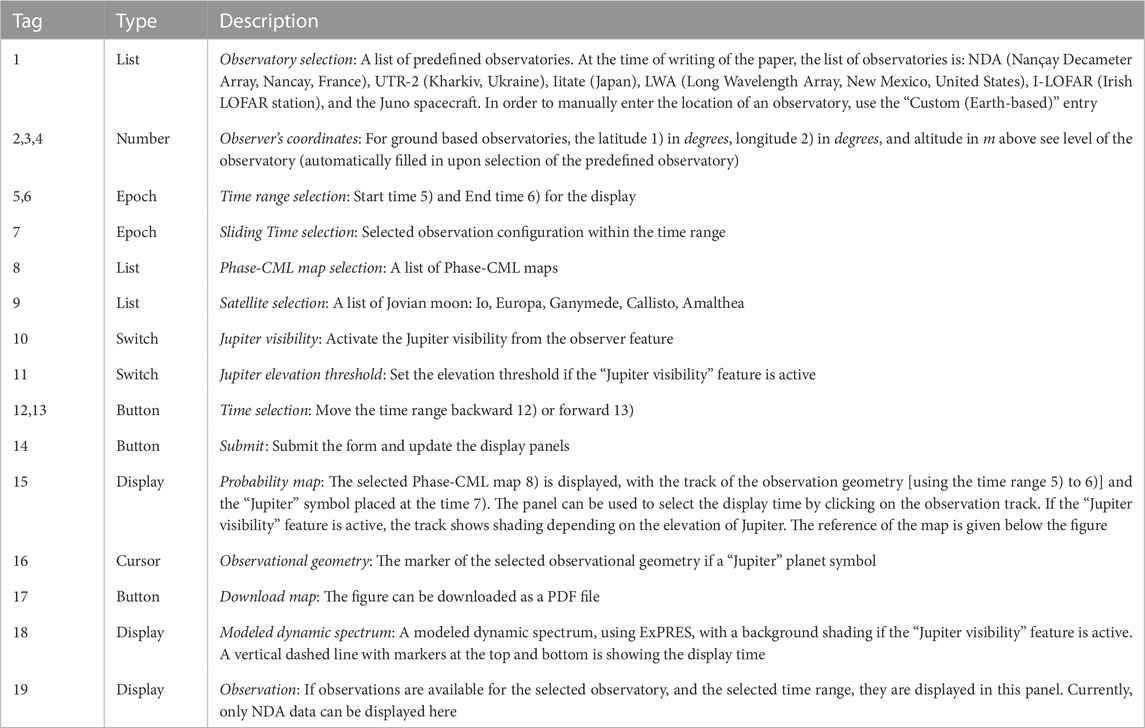- 1LESIA, Observatoire de Paris-PSL, CNRS, Sorbonne Université, Université Paris Cité, Paris, France
- 2ORN, Observatoire de Paris-PSL, Université d'Orléans, CNRS, Nançay, France
- 3DIO, Observatoire de Paris-PSL, CNRS, Paris, France
- 4Aix Marseille Université, CNRS, CNES, LAM, Marseille, France
Jupiter is a source of intense radio emissions in the decametric wavelength range observable from ground (above ∼10 MHz) and from space (down to a few kHz). The strong anisotropy of the Jovian radio sources results in characteristic shapes in the temporal-spectral domain, which can be used to identified the various types of Jovian radio components. The Jupiter Probability Tool provides users with Jovian radio emission observability predictions, depending on the observers location, and the radio emission class. The application can be used for observation planning or data analysis for ground or space observations.
1 Introduction
Jupiter low frequency radio emissions have been studied since their discovery (Burke and Franklin, 1955), with ground (from 10 to 40 MHz) and space observatories (down to a few kHz), the ground based observations being limited by the ionospheric cutoff at ∼10 MHz. The Jovian radio spectrum displays several components, which can be identified in dynamic spectra (time series of spectra), thanks to their temporal-spectral arc-shaped characteristic features (see, e.g.: Zarka, 2000; 2007). Moreover, a subset of Jovian radio components are driven by the interaction between the Jovian magnetic field and the Galilean moons, specifically with the moon Io (Bigg, 1963), but also with Europa and Ganymede (Louis et al., 2017a; Zarka et al., 2018a). The arc-shaped temporal-spectral geometry is a consequence of the radio emission mechanism, which produces a strongly anisotropic beaming pattern. Hence the observer’s location is a key parameter for prediction the observability of Jovian radio emissions. Jupiter observation probability maps have been produced with the first published catalogues (see e.g.: Bigg, 1963; Leblanc et al., 1981), relating the observer’s longitude in the Jovian System III frame (Higgins et al., 1997) and the phase of Io.
Planning or analysing Jupiter radio observations thus requires to know the observation geometry: observation date, observer’s location and phase of the Jovian moons. In this article, we present an online application providing the probability of observing Jovian radio components depending on the observation and Jovian system geometries.
2 Use cases and requirements
The first use case is the analysis of a Jupiter low frequency radio observation. As presented in the introduction section, the interpretation of Jupiter radio emission observations requires an detailed knowledge of the geometry of the Jovian system, together with the observer’s location. The observation configuration shall be displayed in a two-dimensional diagram with axes being (a) the longitude of the observer (usually in Jupiter system III longitude) also known as “Central Meridian Longitude” (or CML), and (b) the selected Moon phase with respect to the observer. Such a diagram is referred to as a “Phase-CML” map. Many Phase-CML maps have been published (see, e.g., Leblanc et al., 1981; Marques et al., 2017; Zarka et al., 2018a). Comparing the selected observation configuration with Phase-CML maps greatly facilitates the Jupiter decametric radio emission observation interpretation. A second critical aspect of the Jovian radio emissions is their shape in the temporal-spectral domain. Comparing the observed shape with predicted ones would also strengthen the scientific interpretation (see, e.g., Louis et al., 2017b).
The second use case is the preparation of a Jupiter low frequency radio observation. The same geometry configuration display against Phase-CML maps allows to select observation times with higher probability of detecting the studied radio component. Furthermore, in order to prepare a ground based observation, the knowledge of Jupiter’s elevation as seen from the observer’s location is also required.
A series of design requirements has been derived from the two use cases.
• Time range: The observation time (or time range) shall be configurable.
• Predefined observer: Space missions with a low frequency instrument (e.g., Cassini, Juno, Wind, STEREO-A, STEREO-B, Galileo...), as well as major ground based low frequency radio observatories (e.g., Long Wavelengths Array, Nançay Decameter Array...) shall be easily configurable.
• Custom ground-based observer: For ground based observation, it shall be possible to set the location of an observatory (e.g., for radio amateur observatories).
• Jovian Moon Control: In the recent studies of Jovian radio emissions, Europa and Ganymede controlled radio emissions have been reported (Louis et al., 2017a; Zarka et al., 2018a) in addition to the long-studied Io-controlled emissions. Control by Callisto and Amalthea are also mentioned in some publications (Marques et al., 2017; Zarka et al., 2018a). The interface shall allow users to select the moon of interest (i.e., Io, Europa, Ganymede, Callisto and Amalthea).
• Phase-CML maps: The various published probability or occurrence Phase-CML maps shall be available for comparison (Lamy et al., 2022), which includes Phase-CML maps from Leblanc et al. (1993); Louis et al. (2017a); Marques et al. (2017); Zarka et al. (2018a,b); Jácome et al. (2022) at the time of writing.
• Observational geometry: The observational geometry shall be displayed on top of a selected Phase-CML map.
• Jupiter elevation: The elevation of Jupiter shall be displayed on the interface in a way the user can tell if the planet is observable at a given time.
• Dynamic Spectra modeling: An estimated model of the observed Jovian dynamic spectrum shall be available.
3 Existing tools
We have identified a set of existing tools serving the identified needs (observation planning and observation interpretation).
3.1 Nançay decameter array probability maps
The Nançay Decameter Array (NDA, Lamy et al., 2017) is a phased array located in Nançay Radioastronomy Observatory (ORN), routinely observing Jupiter and the Sun. In addition to the data products1, the NDA team is providing its users with a series of monthly Io Phase-CML probability maps, as well as the time of the Jupiter transit at the observer’s location, as shown in Figure 1.

FIGURE 1. NDA provided probability maps for Io-controlled Jovian radio emission, on October 2006. The figure presents the observer’s CML on the horizontal axis, and the Io phase on the vertical axis. The dotted lines are the trajectory of the observer in this plane. At the start of each dotted line, the starting day of month of the line is indicated. Each dotted line covers 8 h. The transit time of Jupiter is also provided on the middle tick along this trace. The labels and titles are in French.
3.2 Radio jupiter pro
The Radio Sky Publishing2 team developed tools to help the preparation of Jupiter radio observation, in the frame of the RadioJOVE citizen science project (Thieman et al., 2006; Fung et al., 2020). The Radio Jupiter Pro application3 specifically provides Io Phase-CML probability map, plots indicating the elevation of Jupiter and the Sun at the observer’s location, as well as their location within the antenna beam, when this information is configured. See Figure 2.

FIGURE 2. Radio Jupiter Pro features: (A) Io Phase-CML probability map with the observer’s location marked with the Jupiter planet symbol; (B) elevation of Jupiter at the location of the observer. Tick marks are labelled every hour on the tracks of Jupiter on each panel.
3.3 Jupiter radio map
Jupiter Radio Map4 is a java based application providing the Jovian radio observation probability, in an Io Phase-CML map. This application has been developed by a Japanese team (Kochi National College of Technology, Kochi). The tool displays an Io Phase-CML map, overlaid with the trace of the observational geometry, as selected on the user interface. It also used to be published as an iOS application.
3.4 ExPRES
The ExPRES (Exoplanetary and Planetary Radio Emission Simulator, Louis et al., 2019) is a radio observation modeling code dedicated to planetary radio emissions. It allows to construct dynamic spectra predictions, for an observation geometry and a set of radio emission conditions.
4 Online application
The “Jupiter Probability Tool” application has been designed following the requirements presented in Section 2. The tools cited in Section 3 are already implementing part of project requirements. Hence, our application’s graphical user interface implements some interface features found in existing tools (e.g., the location of Jupiter on the Phase-CML map, similarly to the Radio Jupiter Pro tool, as shown in Figure 2). However, since the previous tools are not open source, none of their code have been reused.
The application is using the SPICE kernel system (Acton et al., 2018) for computing observational and planetary ephemerides. It also displays contextual data, when available, such as observational data (e.g., from the NDA database) and pre-computed modeled data from the ExPRES modeling tool.
The application has been developed as a joint project between the MASER (Measuring, Analysing and Modeling of Emissions in the Radio range) service (Cecconi et al., 2020), and the NDA team (Lamy et al., 2017), with support of PADC (Paris Astronomical Data Centre).
4.1 Graphical user interface
Figure 3 shows a screenshot of the tool user interface. The tagged elements of this interface are described in Table 1. The online Jupiter Probability Tool application (Aicardi et al., 2022) is currently available at: https://jupiter-probability-tool.obspm.fr.

FIGURE 3. Screenshot of the online application. The numbers are referring to the numbered items in Table 1.

TABLE 1. Features of the application graphical user interface, with their type. List items are drop-down menus with predefined values. Number items are text boxes with decimal numbers input. Epoch items are text boxes with date and time input. Switch items are buttons to activate a feature. Button items are used to trigger an action. Display items are showing the result of the query. Cursor items are actionable objects allowing to select a location within a range.
4.2 Development details
The application is developed in python, using the flask5 web development library (Grinberg, 2018). The Solar System bodies and spacecraft ephemerides are retrieved using the python-webgeocalc6 library, accessing a dedicated WebGeoCalc server (Acton et al., 2018) installed at the Observatoire de Paris. That server is configured to serve locally SPICE kernels for NASA, ESA and JAXA space mission. The NDA Jupiter data are retrieved using the das2 (Piker, 2017) protocol, connecting to a das2 server implemented and maintained by the Nançay Data Centre (CDN), at the Nançay Radio Observatory (ORN). The ExPRES simulation runs are retrieved from a local server as CDF7 files, and are accessed using the spacepy. PyCDF (Niehof et al., 2022) module. The application also uses the Pillow8, numpy (Harris et al., 2020), astropy (The Astropy Collaboration et al., 2018), matplotlib (Hunter, 2007) and sqlalchemy (Bayer, 2012).
4.3 Ephemerides computation
The observational geometry is computed in a two-step process. First the location of the observer is retrieved with a STATE_VECTOR query to the WebGeoCalc server, using the LATITUDINAL representation (providing latitude, longitude and distance in the selected frame), the IAU_JUPITER reference frame, and the aberration correction set to CN + S (see WebGeoCalc documentation for details). In the following listings, we assume the timestamp variable is a iterable containing the list of times to be used for computation (list of datetime.datetime objects). The kernels variable contains the list of meta-kernels to be usedfor the current computation. For Earth-based observatories, the Solar System Kernels are selected. For space mission, the specific meta-kernel has to added. Finally, the observer variable contains the observer’s name.
Listing 1. First State Vector query to Webgeocalc: computing CML and time at target
1 from webgeocal import Calculation
2 import numpy as np
3 API = "https://voparis-webgeocalc2.obspm.fr/geocalc/api/"
4 calc_jupiter = Calculation(
5 kernels=kernels,
6 api= API,
7 times=[timestamp.isoformat() for timestamp in timestamps],
8 calculation_type="STATE_VECTOR",
9 target="JUPITER",
10 observer=observer,
11 aberration_correction="CN+S"
12 reference_frame="IAU_JUPITER",
13 state_representation=’LATITUDINAL’,
14 verbose=False
15 )
16 res_jupiter = calc_jupiter.run()
17 cml = (180-np.array(res_jupiter.get("LONGITUDE")))%360
18 date_jupiter = res_jupiter.get("TIME_AT_TARGET")
The CML of the observer is then:
the result of this call also provides a TIME_AT_TARGET. The second query retrieves the location of the selected moon in the IAU_JUPITER reference frame, with a similar STATE_VECTOR query, using the TIME_AT_TARGET, and no aberration correction. In the following listing, the satellite variable contains the name of the selected moon.
Listing 2. Second State Vector query to Webgeocalc: computing the moon’s Phase.
1 calc_moon = Calculation(
2 kernels=kernels,
3 api=API,
4 times=date_jupiter,
5 calculation_type="STATE_VECTOR",
6 target=satellite,
7 observer="JUPITER",
8 aberration_correction="NONE"
9 reference_frame="IAU_JUPITER",
10 state_representation="LATITUDINAL",
11 verbose=False
12 )
13 res_moon = calc_moon.run()
14 phase = (180+cml+np.array(res_moon.get("LONGITUDE")))%360
The Phase of the moon is then:
The elevation of Jupiter for ground observatories is retrieved with a STATE_VECTOR call on the WebGeoCalc server, using the RA_DEC representation. The obtained sky coordinates are transformed into alt-azimuthal coordinates using astropy and the observatory location.
5 Summary and perspectives
The Jupiter Probability Tool application is a science ready tool for preparing and analysing Jupiter radio observations. It has already been used in several studies. Louis et al. (2021) prepared a series of joint Jupiter decametric observations on three international LOFAR stations (Ireland, France and Germany) using the Jupiter Probability Tool. Lamy et al. (2022a) is a comment on a published paper. The authors made use of the application to support their argumentation. Lamy et al. (2022b) also made use of the application to confirm that the observed emissions were Io-controlled emissions.
A series of improvement and new features are planned for the next versions of the application. Firstly, new observatories shall be implemented, especially space missions with low frequency radio instrumentation, such as, e.g., Cassini; STEREO-A; STEREO-B; WIND; Galileo; JUICE; Voyager 1; Voyager 2; and Mars Express. Improvement of the application to adhere to the FAIR (Findable, Accessible, Interoperable, and Reusable) principles (Wilkinson et al., 2016) are also in preparation. One of the planned feature in this context is the addition of provenance (Servillat et al., 2022) information to the output figures (with the provision of the list of citations to be used if the figures are included in a scientific publication), thus improving the reusability of the application products.
Data availability statement
The code of the application is currently not open (except the lines presented in the paper). The data used in this application are all openly available: ExPRES collection (Louis et al., 2020), NDA Jupiter Routine collection (Lamy et al., 2021), Phase-CML maps (Lamy et al., 2022), and the Juno SPICE kernel dataset (Semenov et al., 2017).
Author contributions
BC and LL prepared the application requirements. SA developed the application. BC and LL reviewed and commented the application during the development process. BC wrote the first version of the papier. SA and LL commented and proofread the manuscript.
Funding
The work is supported by the Europlanet 2024 Research Infrastructure project, which has received funding from the European Union’s Horizon 2020 research and innovation programme under grant agreement No 871149.
Acknowledgments
The authors acknowledge support from Observatoire de Paris, CNES (Centre National d'Etudes Spatiale) and CNRS (Centre National de la Recherche Scientifique) through two of its funding programmes: PNP (Programme National de Planétologie) and PNST (Programme National des relations Soleil-Terre). Support from Paris Astronomical Data Centre (PADC) is acknowledged.
Conflict of interest
The authors declare that the research was conducted in the absence of any commercial or financial relationships that could be construed as a potential conflict of interest.
Publisher’s note
All claims expressed in this article are solely those of the authors and do not necessarily represent those of their affiliated organizations, or those of the publisher, the editors and the reviewers. Any product that may be evaluated in this article, or claim that may be made by its manufacturer, is not guaranteed or endorsed by the publisher.
Footnotes
1NDA propability maps: https://realtime.obs-nancay.fr/dam/data_dam_affiche/data_dam_affiche.php?lang=en&planete=jupiter&mode=proba
2Radio Sky Publishing: https://radiosky.com/softwarehome.html
3Radio Jupiter Pro: https://radiosky.com/rjpro3ishere.html
4Jupiter Radio Map: http://jupiter.kochi-ct.jp/jrm/
5flask: https://flask.palletsprojects.com/en/2.2.x/
6Python-Webgeocalc: https://webgeocalc.readthedocs.io/en/latest/
7Common Data Format: https://cdf.gsfc.nasa.gov/
8Pillow: https://pillow.readthedocs.io/en/stable/
References
Acton, C., Bachman, N., Semenov, B., and Wright, E. (2018). A look towards the future in the handling of space science mission geometry. Planet. Space Sci. 150, 9–12. doi:10.1016/j.pss.2017.02.013
Aicardi, S., Cecconi, B., and Lamy, L. (2022). Jupiter radio probability tool. PADC/MASER. doi:10.25935/TV9M-HX48
Bayer, M. (2012). “Sqlalchemy,” in The architecture of open source applications volume II: Structure, scale, and a few more fearless hacks Editors A. Brown, and G. Wilson Available at: http://aosabook.org/en/sqlalchemy.html.
Bigg, K. E. (1963). Influence of the satellite Io on jupiter's decametric emission. Nature 203, 1008–1010. doi:10.1038/2031008a0
Burke, B. F., and Franklin, K. L. (1955). Observations of a variable radio source associated with the planet jupiter. J. Geophys. Res. 60, 213–217. doi:10.1029/jz060i002p00213
Cecconi, B., Loh, A., Sidaner, P. L., Savalle, R., Bonnin, X., Nguyen, Q. N., et al. (2020). Maser: A science ready toolbox for low frequency radio Astronomy. Data Sci. J. 19, 1062. doi:10.5334/dsj-2020-012
Fung, S. F., Typinski, D., Flagg, R., Ashcraft, T., Greenman, W., Higgins, C., et al. (2020). Propagation teepee: A possible high-frequency (15–30 mhz) remote lightning signature identified by citizen scientists. Geophys. Res. Lett. 47, e2020GL087307. doi:10.1029/2020GL087307
Grinberg, M. (2018). Flask web development: Developing web applications with python. O’Reilly Media, Inc.
Harris, C. R., Millman, K. J., van der Walt, S. J., Gommers, R., Virtanen, P., Cournapeau, D., et al. (2020). Array programming with NumPy. Nature 585, 357–362. doi:10.1038/s41586-020-2649-2
Higgins, C., Carr, T. D., Reyes, F., Greenman, W., and Lebo, G. (1997). A redefinition of Jupiter’s rotation period. J. Geophys. Res. 102, 22033–22041. doi:10.1029/97ja02090
Hunter, J. D. (2007). Matplotlib: A 2d graphics environment. Comput. Sci. Eng. 9, 90–95. doi:10.1109/MCSE.2007.55
Jácome, H. R. P., Marques, M. S., Zarka, P., Echer, E., Lamy, L., and Louis, C. K. (2022). Search for jovian decametric emission induced by Europa on the extensive Nançay decameter array catalog. Astronomy Astrophysics 665, A67. doi:10.1051/0004-6361/202244246
Lamy, L., Cecconi, B., and Aicardi, S. (2022). Collection of jovian radio emission probability and occurrence maps. PADC/MASER. doi:10.25935/1ZBG-EK27
Lamy, L., Cecconi, B., Aicardi, S., Louis, C. K., K. Louis, C., et al. Station de Radioastronomie de Nancay, Observatoire de Paris, Universite PSL, CNRS, Univ. Orleans, 18330 Nancay, France (2022a). Comment on “Locating the source field lines of Jovian decametric radio emissions” by YuMing Wang et al. Earth Planet. Phys. 6, 10–12. doi:10.26464/epp2022018
Lamy, L., Colomban, L., Zarka, P., Prangé, R., Marques, M. S., Louis, C. K., et al. (2022b). Determining the beaming of Io decametric emissions: A remote diagnostic to probe the io-jupiter interaction. J. Geophys. Res. Space Phys. 127, 30160. doi:10.1029/2021ja030160
Lamy, L., Le Gall, A., Cecconi, B., Loh, A., Renaud, P., Denis, L., et al. (2021). Nançay decameter array (NDA) routine jupiter observation data collection. PADC/CDN. doi:10.25935/DV2F-X016
Lamy, L., Zarka, P., Cecconi, B., Klein, K.-L., Masson, S., Denis, L., et al. (2017). 1977–2017: 40 Years of decametric observations of jupiter and the Sun with the Nançay decameter array. Planet. Sol. Heliospheric Radio Emiss. (PRE VIII) 8, 455–466. doi:10.1553/pre8s455
Leblanc, Y., Gerbault, A., Denis, L., and Lecacheux, A. (1993). A catalogue of Jovian decametric radio observations from January 1988 to December 1990. Astron. Astrophys. Suppl. Ser. 98, 529.
Leblanc, Y., Noë, J. d. l., Genova, F., Gerbault, A., and Lecacheux, A. (1981). A catalogue of jovian decametric radio observzations from January 1978 to December 1979. Astron. Astrophys. Suppl. Ser. 46, 135.
Louis, C., Cecconi, B., and Loh, A. (2020). ExPRES jovian radio emission simulations data collection (version 01). PADC/MASER. doi:10.25935/KPGE-ZB59
Louis, C. K., Hess, S. L. G., Cecconi, B., Zarka, P., Lamy, L., Aicardi, S., et al. (2019). ExPRES: An exoplanetary and planetary radio emissions simulator. Astronomy Astrophysics 627, A30. doi:10.1051/0004-6361/201935161
Louis, C. K., Jackman, C. M., Griessmeier, J.-M., Wucknitz, O., McKenna, D. J., Murphy, P., et al. (2021). Observing Jupiter’s radio emissions using multiple LOFAR stations: A first case study of the io-decametric emission using the Irish IE613, French FR606 and German DE604 stations. MNRAS in press. doi:10.48550/arxiv.2111.09599
Louis, C. K., Lamy, L., Zarka, P., Cecconi, B., and Hess, S. L. G. (2017a). Detection of jupiter decametric emissions controlled by Europa and Ganymede with voyager/PRA and Cassini/RPWS. J. Geophys. Res. Space Phys. 122, 9228–9247. doi:10.1002/2016ja023779
Louis, C. K., Lamy, L., Zarka, P., Cecconi, B., Imai, M., Kurth, W. S., et al. (2017b). Io-Jupiter decametric arcs observed by Juno/Waves compared to ExPRES simulations. Geophys. Res. Lett. 1, 9225–9232. doi:10.1002/2017gl073036
Marques, M. S., Zarka, P., Echer, E., Ryabov, A. V., Alves, M. V., Denis, L., et al. (2017). Statistical analysis of 26 yr of observations of decametric radio emissions from Jupiter. Astronomy Astrophysics 604, A17. doi:10.1051/0004-6361/201630025
Niehof, J. T., Morley, S. K., Welling, D. T., and Larsen, B. A. (2022). The SpacePy space science package at 12 years. Front. Astronomy Space Sci. 9, 612. doi:10.3389/fspas.2022.1023612
The Astropy Collaboration, Price-Whelan, A. M., Sipőcz, B. M., Günther, H. M., Lim, P. L., Crawford, S. M., et al. (2018). The astropy project: Building an open-science project and status of the v2.0 core package. Astrophys. J. 156, 123. doi:10.3847/1538-3881/aabc4f
Semenov, B. V., Acton, C. H., and Costa Sitja, M. (2017). JUNO SPICE KERNELS V1.0, JNO-J/E/SS-SPICE-6-V1.0. NASA Planetary Data System. doi:10.17189/1520117
Servillat, M., Bonnarel, F., Louys, M., and Sanguillon, M. (2022). “Practical provenance in Astronomy,” in Astronomical society of the pacific conference series. Editors J. E. Ruiz, F. Pierfedereci, and P. Teuben (Astronomical Society of the Pacific Conference Series), 532, 619.
Thieman, J., Flagg, R., Sky, J., Higgins, C., Garcia, L., Reyes, F., et al. (2006). The radio JOVE project: Amateurs working with professionals. Planet. Radio Emiss. VI, 225–230.
Wilkinson, M. D., Dumontier, M., Aalbersberg, I. J., Appleton, G., Axton, M., Baak, A., et al. (2016). The FAIR Guiding Principles for scientific data management and stewardship. Sci. Data 3, 160018. doi:10.1038/sdata.2016.18
Zarka, P., Marques, M. S., Louis, C., Ryabov, V. B., Lamy, L., Echer, E., et al. (2018a). Jupiter radio emission induced by Ganymede and consequences for the radio detection of exoplanets. Astronomy Astrophysics 618, A84. doi:10.1051/0004-6361/201833586
Zarka, P., Marques, M. S., Louis, C., Ryabov, V. B., Lamy, L., Echer, E., et al. (2018b). Radio emission from satellite-Jupiter interactions (especially Ganymede). Planet. RADIO Emiss. VIII 8, 45–58. doi:10.1553/pre8s45
Zarka, P. (2000). “Radio emissions from the planets and their moons,” in Radio astronomy at long wavelengths, geophysical monograph series. Editors R. G. Stone, K. W. Weiler, M. L. Goldstein, and J.-L. Bougeret (Washington, DC: American Geophysical Union), 167–178. doi:10.1029/GM119p0167
Keywords: jupiter, radio emissions, space physics, online application, observation planning, python
Citation: Cecconi B, Aicardi S and Lamy L (2023) Jupiter radio emission probability tool. Front. Astron. Space Sci. 10:1091967. doi: 10.3389/fspas.2023.1091967
Received: 07 November 2022; Accepted: 09 January 2023;
Published: 16 February 2023.
Edited by:
Angeline G. Burrell, United States Naval Research Laboratory, United StatesReviewed by:
Fabio Lepreti, University of Calabria, ItalyNickolay Ivchenko, Royal Institute of Technology, Sweden
Copyright © 2023 Cecconi, Aicardi and Lamy. This is an open-access article distributed under the terms of the Creative Commons Attribution License (CC BY). The use, distribution or reproduction in other forums is permitted, provided the original author(s) and the copyright owner(s) are credited and that the original publication in this journal is cited, in accordance with accepted academic practice. No use, distribution or reproduction is permitted which does not comply with these terms.
*Correspondence: B. Cecconi, YmFwdGlzdGUuY2VjY29uaUBvYnNlcnZhdG9pcmVkZXBhcmlzLnBzbC5ldQ==
 B. Cecconi
B. Cecconi S. Aicardi
S. Aicardi L. Lamy
L. Lamy